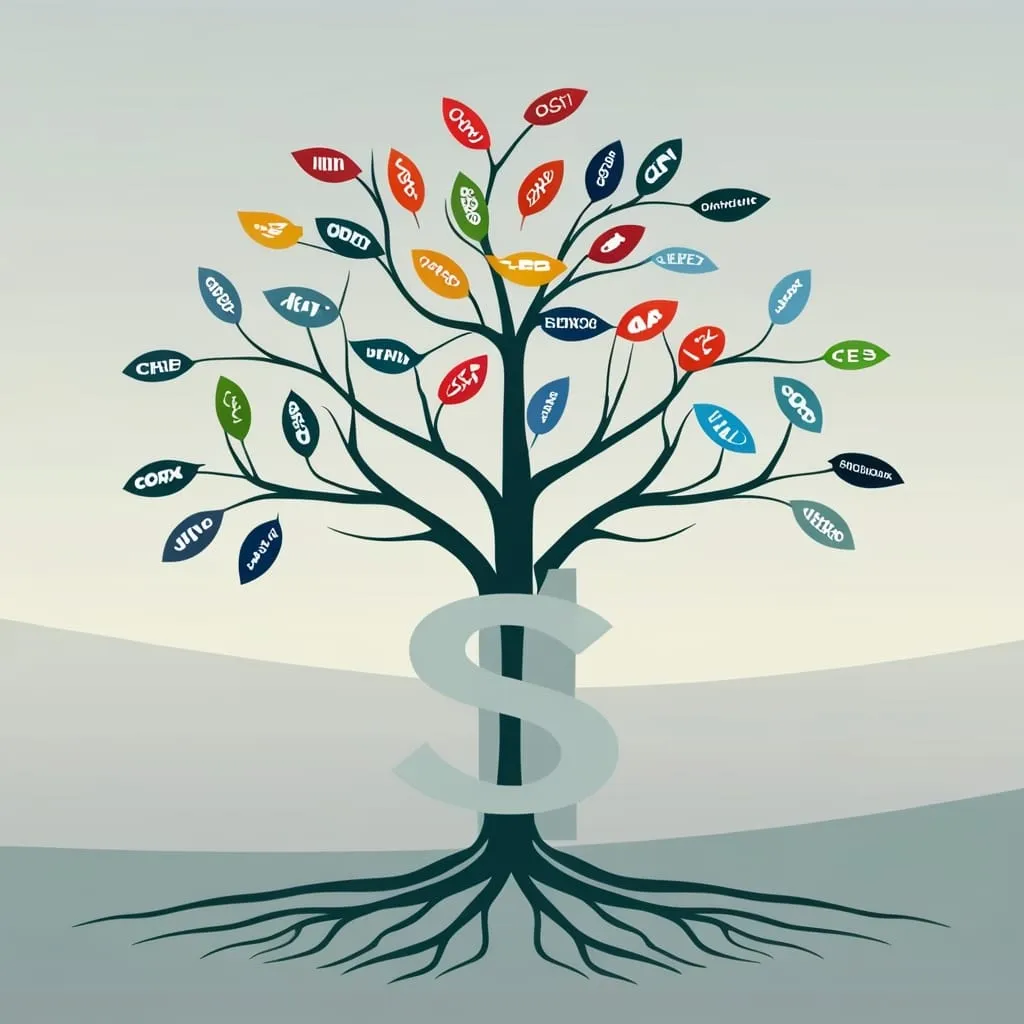We've often talked about the importance of an emergency fund and insurances on this channel. Today, we're looking at the topic from a different angle by examining the risks of not having one. It's a stark reality for 90% of people worldwide. This becomes particularly alarming in regions where healthcare is costly. For those not fortunate enough to have access to the comprehensive healthcare benefits available in many European countries, this article aims to serve as a wake-up call. If you find yourself without health insurance in a system where medical bills can be financially overwhelming, it's time to take notice.
Golden Security: Safeguarding Your Future with Gold
Choosing the right Life Cover
Higher Medical Cost
The financial burden of healthcare is immense and universally acknowledged, yet the sheer scale of high medical costs continues to shock. Across the globe, from the U.S. to Asia, individuals face exorbitant charges for everything from emergency procedures to routine care and long-term treatments. These costs aren't merely high. They're often prohibitive, with a single treatment or emergency visit potentially running into thousands of dollars. Such expenses can deplete savings rapidly, push families into debt, or worse, lead to avoidance of necessary medical care altogether.
As of 2022, the median household income in the U.S. was approximately $74,580 (Census.gov). Individual earnings vary, but this gives us a baseline for understanding what a typical household might have available annually before taxes. Also Data suggests that a significant portion of Americans have less than $1,000 saved, which indicates a general lack of preparedness for any substantial expenses (Census.gov). Medical bills in the U.S. can be prohibitively expensive, often reaching several thousands of dollars for relatively common procedures. For instance, the cost of an appendectomy can vary widely but often exceeds $10,000, and more complicated procedures or treatments for serious conditions can climb much higher.
Given these points, it’s clear that a single medical emergency could easily surpass the available savings of the typical American household, potentially pushing them towards financial instability or even bankruptcy, especially if they lack adequate health insurance to cover these costs. This scenario underscores the precarious financial balance in which many households find themselves, where a single health incident can have severe economic consequences.
Inadequate Insurance Coverage
A significant issue is that many insurance plans do not cover all the necessary medical expenses. This includes high deductibles, copayments, and exclusions for certain treatments or medications. Underinsurance means that even though individuals have health insurance, the out-of-pocket expenses can still be financially overwhelming.
Many health insurance policies have gaps in coverage that can result in substantial out-of-pocket costs for patients. These gaps might be for certain types of healthcare services, such as mental health care or specialized surgeries, which are not fully covered under standard health insurance policies.
High premiums can also be a barrier to maintaining adequate insurance coverage. For many, especially in the lower income brackets, the cost of health insurance is prohibitively expensive, forcing them to choose plans with lower premiums but higher out-of-pocket costs or to forego insurance altogether.
Some insurance policies have annual or lifetime coverage limits. Once these limits are reached, the policyholder must pay all costs out-of-pocket, which can quickly lead to financial distress if a serious illness or injury occurs.
There are also issues related to the accessibility of insurance. Some individuals may not have sufficient knowledge about how to choose the best insurance plan for their needs or may live in regions where few options are available. Additionally, complexities in the enrollment process can deter people from obtaining insurance.
Addressing these issues involves both policy changes to improve the quality and reach of health insurance and increased public awareness about the importance of adequate coverage.
Economic Inequality and Health Disparities
The link between economic inequality and health disparities is a critical aspect of understanding why so many people face financial ruin due to medical bills. Those with lower socioeconomic status often experience worse health outcomes, which can be attributed to several factors.
Firstly, access to healthcare is a major issue. People in lower-income brackets might have fewer healthcare facilities in their communities, lower-quality care, and less access to preventative services. This lack of access increases the likelihood of medical emergencies and more severe health issues that are more costly to treat.
Secondly, there's a direct correlation between economic status and the prevalence of chronic diseases. Conditions such as diabetes, heart disease, and respiratory illnesses are more common among those with lower incomes, partly due to the stress associated with financial instability, limited access to healthy food, and less opportunity for physical activity.
Moreover, healthcare affordability continues to be a major barrier. Even with insurance, the high cost of treatments and medications can be prohibitive for those on limited budgets, leading to skipped treatments and worsening health conditions. This cycle of poor health and high medical costs perpetuates economic inequality, as those with health issues are less able to work or may lose employment due to illness, further exacerbating their financial and health crises.
Addressing these disparities requires a comprehensive approach that includes policy reforms aimed at increasing access to quality healthcare for all, improving the conditions of low-income neighborhoods, and enhancing health education and preventative care programs to mitigate the impacts of economic inequality on health outcomes.
Chronic Illnesses and Long-Term Care Costs
Chronic illnesses and the associated long-term care costs present a significant financial challenge for many individuals and families. These ongoing medical needs can lead to continuous out-of-pocket expenses that accumulate over years, sometimes lasting a lifetime.
Conditions like diabetes, heart disease, and chronic respiratory diseases require regular medical attention, medications, and possibly lifestyle adjustments that can be costly. The management of these diseases often involves frequent doctor visits, multiple medications, and sometimes special treatments or procedures. The burden of managing these costs on a continual basis can strain any budget and lead to significant financial hardship.
Beyond the direct medical costs associated with chronic illnesses, there are often substantial long-term care needs. This can include home care services, nursing home care, and other forms of assistance that are not always covered by insurance. These services are particularly relevant for aging populations who may suffer from multiple chronic conditions that impair their ability to perform daily tasks.
The costs associated with chronic illnesses and long-term care can deplete savings quickly, undermine financial stability, and reduce the quality of life. For many, this means making difficult choices between necessary healthcare and other financial obligations, which can exacerbate health problems if economical choices lead to compromised care.
To mitigate these challenges, there is a need for more comprehensive insurance options that cover long-term care and chronic disease management more effectively. Additionally, support systems such as community health programs and subsidized healthcare services can play a crucial role in alleviating the financial burden on individuals and families dealing with chronic illnesses.
Addressing these issues involves not only personal financial planning but also broader healthcare policy reforms aimed at supporting those with long-term and chronic health conditions. This ensures that all individuals can access and afford the care they need without the risk of financial disaster.
Mental and Emotional Toll of Medical Debt
The mental and emotional toll of medical debt is a significant and often under-discussed consequence of healthcare-related financial struggles. The stress of facing large medical bills can lead to serious mental health issues, including anxiety, depression, and chronic stress, particularly when individuals feel powerless over their financial situation.
The constant worry about how to pay medical bills or the choice between medical care and other essential needs can be overwhelming. Studies have shown that individuals with high medical debt are more likely to experience a deterioration in their mental health, as the stress can be both relentless and isolating.
Beyond the immediate stress responses, long-term anxiety related to financial instability can affect overall quality of life. It can lead to reduced social interaction, withdrawal from recreational activities, and a pervasive sense of hopelessness. This emotional strain can exacerbate existing health problems or lead to new ones, creating a vicious cycle of health and financial decline.
The strain of medical debt can also extend to family dynamics and relationships. The stress associated with financial insecurity can lead to tension and conflict within families, affecting marital satisfaction and even parenting styles. In some cases, the burden of debt can lead to long-term changes in family structure and stability.
Addressing the mental health impact of medical debt requires effective coping mechanisms and support systems. This might include counseling services, stress management programs, and community support groups, which can provide emotional and practical support to those struggling.
On a broader scale, integrating mental health services with financial counseling and medical care could help mitigate the psychological impacts of medical debt. Policy interventions that aim to reduce the burden of medical costs and improve insurance coverage could also significantly reduce the mental health repercussions for many affected individuals.
Conclusion
Wrapping up the discussion, the importance of an emergency fund and adequate insurance cannot be overstated, especially in light of the financial vulnerabilities exposed by medical emergencies. These financial safety nets provide a buffer that can help individuals and families manage unexpected expenses without falling into debt or experiencing financial ruin.
An emergency fund is a crucial financial tool that offers a cushion against unexpected expenses, such as medical bills, urgent home repairs, or sudden job loss. Financial advisors typically recommend saving enough to cover three to six months' worth of living expenses. Starting an emergency fund can be as simple as setting aside a small, manageable amount of money each month. No matter your age, it's never too late to start building this fund. Even small contributions can grow over time and provide significant financial security.
Health insurance is equally important as it can significantly reduce the out-of-pocket costs associated with medical care. Evaluating your healthcare needs and understanding the different insurance plans available can help you choose coverage that best suits your situation. For those who find traditional insurance plans expensive, exploring options like health savings accounts (HSAs) or joining a health sharing plan might offer alternative solutions.
It is never too late to start building an emergency fund or to explore insurance options. Atleast for the insurances you have an age limit, but for building a substancial emergency fund, there is no one particular number that i cna think of.
Just Determine how much money you need in your emergency fund and what kind of health coverage you need based on your health history and family responsibilities. Adjust your budget to allocate funds towards your emergency savings and insurance premiums. Even reallocating small amounts from daily expenses can help build up your fund.
Setting up automatic transfers to a savings account can help you stay consistent with your savings goals. Regularly review and adjust your insurance coverage as your health needs and financial situation change over time.






